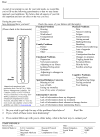Distress screening in a multidisciplinary lung cancer clinic: prevalence and predictors of clinically significant distress
- PMID: 17084483
- PMCID: PMC1857305
- DOI: 10.1016/j.lungcan.2006.10.001
Distress screening in a multidisciplinary lung cancer clinic: prevalence and predictors of clinically significant distress
Abstract
Screening for distress in cancer patients is recommended by the National Comprehensive Cancer Network, and a Distress Thermometer has previously been developed and empirically validated for this purpose. The present study sought to determine the rates and predictors of distress in a sample of patients being seen in a multidisciplinary lung cancer clinic. Consecutive patients (N=333) were recruited from an outpatient multidisciplinary lung cancer clinic to complete the Distress Thermometer, an associated Problem Symptom List, and two questions about interest in receiving help for symptoms. Over half (61.6%) of patients reported distress at a clinically significant level, and 22.5% of patients indicated interest in receiving help with their distress and/or symptoms. Problems in the areas of family relationships, emotional functioning, lack of information about diagnosis/treatment, physical functioning, and cognitive functioning were associated with higher reports of distress. Specific symptoms of depression, anxiety, pain and fatigue were most predictive of distress. Younger age was also associated with higher levels of distress. Distress was not associated with other clinical variables, including stage of illness or medical treatment approach. Similar results were obtained when individuals who had not yet received a definitive diagnosis of lung cancer (n=134) were excluded from analyses; however, family problems and anxiety were no longer predictive of distress. Screening for distress in a multidisciplinary lung cancer clinic is feasible and a significant number of patients can be expected to meet clinical criteria for distress. Results also highlight younger age and specific physical and psychosocial symptoms as predictive of clinically significant distress. Identification of the presence and predictors of distress are the first steps toward appropriate referral and treatment of symptoms and problems that contribute to cancer patients' distress.
Conflict of interest statement
Conflict of Interest Statement
None declared.
Figures

References
-
- National Comprehensive Cancer Network. Distress management clinical practice guidelines. J Natl Comp Cancer Network. 2003;1:344–374. - PubMed
-
- Holland J. Psychological care of patients: Psycho-oncology’s contributions. J Clin Oncol. 2003;21:253s–265s. - PubMed
-
- Kurtz ME, Kurtz JC, Stommel M, Given CW, Given B. Predictors of depressive symptomatology of geriatric patients with lung cancer-a longitudinal analysis. Psychooncology. 2002;11:12–22. - PubMed
-
- McDaniel JS, Musselman DL, Porter MR, Reed DA, Nemeroff CB. Depression in patients with cancer. Diagnosis, biology, and treatment. Arch Gen Psychiatry. 1995;52:89–99. - PubMed
-
- Cella DF, Orofiamma B, Holland JC, Silberfarb PM, Tross S, Feldstein M, Perry M, Maurer LH, Comis R, Oray EJ. The relationship of psychological distress, extent of disease, and performance status in patients with lung cancer. Cancer. 1987;60:1661–1667. - PubMed
Publication types
MeSH terms
Grants and funding
LinkOut - more resources
Full Text Sources
Medical

